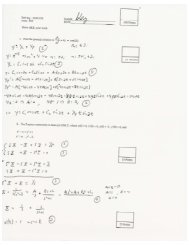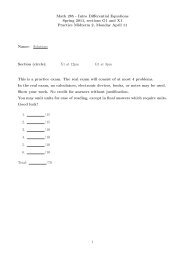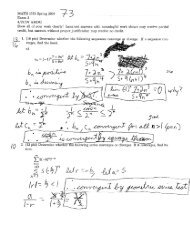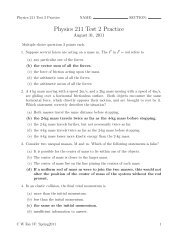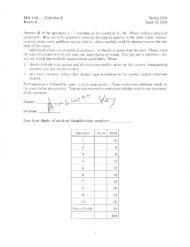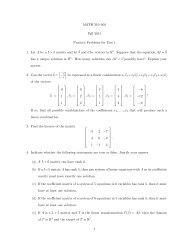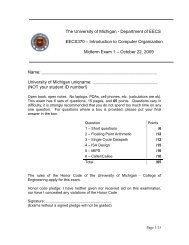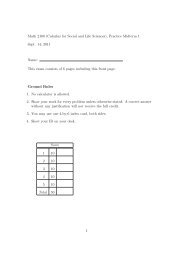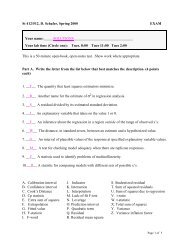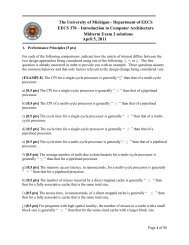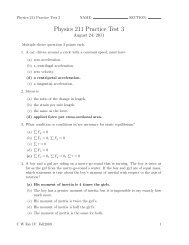Solutions to Additional Conceptual Practice Problems for PHYS 1112 Final Exam
PHYS 1112 – Exam 4 w Solutions (2010) – Intro to Physics 2
PHYS 1112 – Exam 4 w Solutions (2010) – Intro to Physics 2
Create successful ePaper yourself
Turn your PDF publications into a flip-book with our unique Google optimized e-Paper software.
Physics <strong>1112</strong>Spring 2009University of GeorgiaInstruc<strong>to</strong>r: HBSchüttlerDetailed Problem Statement:A bar magnet is moved either <strong>to</strong>wards or away from a circular conducting ring with eitherits north-pole (N) or its south-pole (S) pointing <strong>to</strong>wards the ring, and the respective polebeing located either above the plane of the ring (in ”Top” position ”T”) or below the planeof the ring (in ”Bot<strong>to</strong>m” position ”B”), as shown in the Fig. As also shown in Fig., theplane of the ring defines the x-y-plane, and the magnet’s N-S-axis is oriented parallel <strong>to</strong> thez-axis while the magnet is being moved.Which of the five motion processes of the bar magnet, (A)-(E) described above, will inducea clockwise (cw) current I in the ring?Solution:Above/below the poles of the bar magnet, ⃗ B points approximately along the z-axis, ou<strong>to</strong>f the N- and in<strong>to</strong> the S-pole, with the field strength B ≡ | ⃗ B| decreasing with increasingdistance from either pole.Hence, the magnetic field ⃗ B inside the ring points in +z-direction when the N-pole is belowthe ring pointing up (in Bot<strong>to</strong>m position ”B”) or when the S-pole is above the ring pointingdown (in Top position ”T”). Likewise, ⃗ B inside the ring points in −z-direction when theS-pole is below the ring pointing up (in Bot<strong>to</strong>m position ”B”) or when the N-pole is abovethe ring pointing down (in Top position ”T”). Also, the field strength B inside the ringincreases if either pole is moving <strong>to</strong>wards the ring; and the field strength B inside the ringdecreases if either pole is moving away from the ring.By Lenz’s rule, the induced current I in the ring produces a secondary field, ⃗ BI , whichopposes the change ∆ ⃗ B of the time-dependent inducing field ⃗ B(t). Also, the direction of I isrelated <strong>to</strong> the ⃗ B I -direction by a right-hand (RH) rule: if RH thumb is in direction of ⃗ B I , theRH 4 fingers point in the flow direction of I. So, <strong>to</strong> produce a ⃗ B I pointing in −z-directionrequires a clockwise I, as defined in Fig.; <strong>to</strong> produce a ⃗ B I pointing in +z-direction requiresa counter-clockwise I.Hence, ∆ ⃗ B points in +z-direction, and by Lenz’s rule, ⃗ B I points in −z-direction, and I flowsclockwise ifCase (1): ⃗ B points in +z-direction and its strength B increases in magnitude; orCase (2): ⃗ B points in −z-direction and its strength B decreases in magnitude.Likewise, ∆ ⃗ B points in −z-direction, and by Lenz’s rule, ⃗ B I points in +z-direction, and Iflows counter-clockwise ifCase (3): ⃗ B points in +z-direction and its strength B decreases in magnitude; orCase (4): ⃗ B points in −z-direction and its strength B increases in magnitude.Thus, in the answer key above, process (A) corresponds <strong>to</strong> Case (1), process (B) corresponds<strong>to</strong> Case (3), process (C) corresponds <strong>to</strong> Case (4), process (D) corresponds <strong>to</strong> Case (4), andprocess (E) corresponds <strong>to</strong> Case (3). So, only process (A) induces a clockwise current, while(B), (C), (D) and (E) all induce a counter-clockwise current in the ring.2



